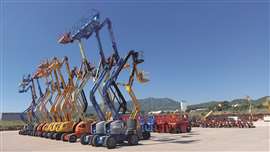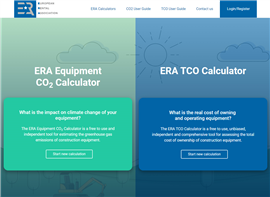Read this article in French German Spanish
Sun, sea and specialist rental: How Spanish plant hire firm Manain is navigating a buoyant market
23 July 2025
In Spain’s buoyant construction and equipment rental sector, mid-sized operators face a complex blend of local competition and global disruption. One company navigating that terrain with uncommon agility is Manain, a Catalonia-based rental firm whose unorthodox model is yielding both resilience and growth. Founder Albert Borràs, tells Euan Youdale why.
 Equipment at a Manain depot in Catalonia. Photo: Manain
Equipment at a Manain depot in Catalonia. Photo: Manain
“We are not a normal rental company,” says Albert Borràs, founder of Catalonia-based construction equipment rental firm Manain.
It’s a statement borne out by the figures: half of Manain’s revenues now stem from equipment sales—particularly of mobile elevating work platforms (MEWPs)—alongside its core rental business. The firm’s fleet includes 1,400 aerial platforms out of 2,000 total machines, complemented by telehandlers, excavators, generators and dumpers.
Founded in 2003 as a generalist rental and repair outfit, Manain pivoted to access equipment in 2005—a decision that has defined its trajectory. “It was the last product that we put in our fleet and now it is the most important,” Borràs explains. “We had already been doing sales in access, which was doing very well, so it was easy for us to focus our rental fleet on access also.”
Operating across the Catalan coast with four depots, including two in Barcelona, the company maintains a domestic rental footprint but exports its sales operations globally, with clients across Europe, Latin America and parts of Asia.
After a rapid expansion phase from 2016 to 2020, when growth exceeded 45% year-on-year, Manain has since proceeded with more measured development. The appointment of a CEO in 2022 marked a period of consolidation, with annual growth now targeted at a sustainable 10%.
“We are quite happy — we are growing slowly but that’s what we want — that’s our target. We have professionalised the company a lot — you can’t grow 30%-40% every year,” says Borràs.
This discipline extends to fleet renewal. With most equipment dating from 2023 or 2024, Manain maintains one of the youngest rental fleets in the market. “We sell a lot, so we are also renewing the fleet very often,” Borràs notes. “We sell new or even used machines that are around one year old, so we have to buy a lot too.”
 Albert Borràs, founder of Manain. Photo: Manain
Albert Borràs, founder of Manain. Photo: Manain
The implications are twofold: a high capital expenditure requirement and logistical complexity. Yet Borràs insists it is worth the investment. “Most other rental companies have older fleets and it makes it easier for us to win projects as many customers are becoming more demanding… if you renew the fleet as often as we do, then you have the latest technology and the latest safety elements.”
Spain is home to approximately 300–400 equipment rental companies, with an estimated 65,000 access platforms in operation, according to industry body ANAPAT. The market is dominated by international players such as Loxam, Mateco and Kiloutou, alongside major domestic player GAM.
While Borràs acknowledges the scale advantages of these giants, he sees strategic agility as the preserve of firms like his. “I think the main difference with the big companies is that they have very wide coverage and are focused heavily in making efficiencies across their networks. But they are not as fast at taking decisions on the ground as the smaller and medium-sized companies.”
Manain is not chasing size for its own sake. “Why would you put another 1,000 machines into the market if you don’t have the people to support them and you have the financial risk of those machines?” Borràs asks. “Let’s see what happens… if the market remains good and the economy grows then that’s perfect, but if it slows down then you can be in trouble.”
While Spain remains one of Europe’s most resilient construction markets, with growth forecasts of 4.5–6.5% this year according to KPMG, rental businesses are not immune to macroeconomic pressures. Tariffs on Chinese MEWPs have disrupted sourcing strategies across the EU.
“The Chinese prices will now rise to the same as the US and European brands,” says Borràs. “So, I guess we will carry on as before with the older brands.” Still, the company will continue to operate with the Chinese stock already imported before the 2025 tariffs came into effect.
In a broader reflection on the market, he adds: “Western manufacturers have put their prices up due to higher component costs and the Chinese due to the tariffs. I think the western brands have to focus on technology because the Chinese brands are far more advanced with their production technology… not because of labour costs but because they have the technology in the production lines.”
Like many of its peers, Manain is grappling with a shortage of skilled labour. “The machines are easy to buy but finding people to make them work is not easy — that’s one of the main challenges that we have in the future,” says Borràs. “We don’t have technicians, it’s not easy to find salespeople, and it’s the same in other parts of the business. That is what stops the growth.”
While telematics and fleet digitisation are seen as possible mitigations, Manain’s rapid fleet turnover complicates long-term tech investments. “We are not a normal rental company; we replace half of our fleet nearly every two years, so it’s difficult to invest in telematics then take it out.”
 A Manain truck in Barcelona. Photo: Manain
A Manain truck in Barcelona. Photo: Manain
To counter a broad market of stagnant rental prices — flat for five years despite strong demand — Manain has adopted a cautious strategy of incremental rate increases. “We are raising the prices each year – not a lot but a little bit, especially for machines that have a high utilisation rate,” says Borràs. “Maybe after a few years they will be 10% higher.”
While some of its peers bet heavily on further growth this year and next, Manain is hedging against potential headwinds. “I know there are some companies taking that risk… but if [the market] slows down then you can be in trouble. This is what happened in Spain and the rest of Europe in 2008, so you have to keep the balance.”
As the sector anticipates the tapering of EU Recovery Funds in 2026, and with labour and inflationary pressures persisting, Manain’s hybrid model — part-rental, part-trading — may prove not only adaptive but instructive.
“We have to improve our processes and lose as little time as possible,” Borràs adds. “If you compare it to how we worked 10 years ago our company is more efficient and we have to keep working hard at that, especially at this time with a lack of labour.”
Southern Europe defies continental slowdown
Once seen as one of the weakest economies in Europe, dogged by high unemployment and stagnation, since the pandemic, Spain’s economy has experienced a significant turnaround and has been easily outgrowing the likes of Germany, France, Italy and the United Kingdom. While many European economies are floundering in 2025, Spain’s GDP is forecast to grow as much as 2.5% this year, due mostly to a surge in immigration, a boom in the tourism market and cheap energy prices.
Similarly, Spain’s construction rental market continues to outperform. According to the European Rental Association’s latest outlook, the Spanish market is forecast to expand by over 6% in 2025, led by infrastructure investment and EU recovery funding.
In Q1 2025, national rental group GAM reported a 9% increase in revenue year-on-year to €73.5 million, with rental and services up 15%. The company credited its circular economy model for lowering capital expenditure by 17%.
Residential and non-residential construction have also held up well, buoyed by delayed infrastructure spending and a spike in demand for modern office space. Anmopyc, Spain’s equipment manufacturers’ association, forecasts a further 3.5% sectoral growth in 2026—despite concerns over labour shortages and input costs.
STAY CONNECTED



Receive the information you need when you need it through our world-leading magazines, newsletters and daily briefings.
CONNECT WITH THE TEAM









